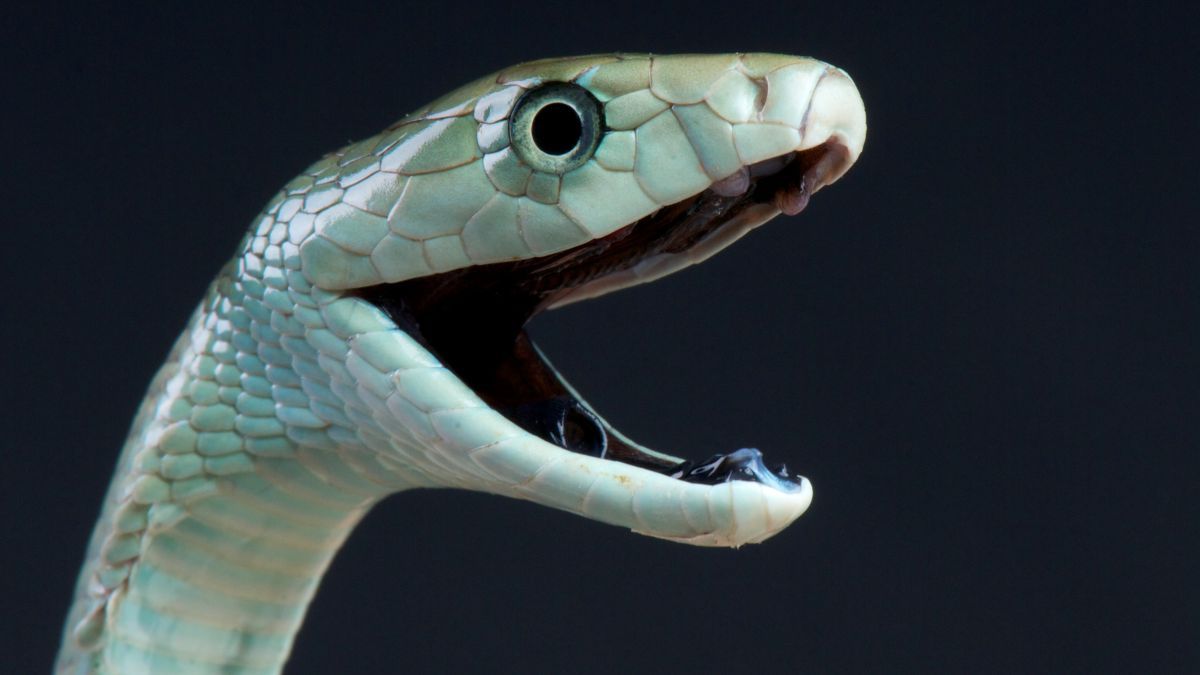Watch 2 giant, highly venomous black mambas fighting in someone's backyard
The black mamba (Dendroaspis polylepis) is one of the deadliest species of snake on Earth. (Image credit: reptiles4all/Getty Images)
Two huge, highly venomous black mambas — both over 8 feet (2.4 meters) long — have been filmed in a fierce wrestling match in a person's backyard.
The males fought for over 30 minutes in Queensburgh, South Africa. The pair were filmed in a twisted embrace as they attempted to pull each other to the ground.
The bigger snake, which was 8.5 feet (2.6 m) long and weighed 660 pounds (300 kilograms), tried to pin down the neck of the smaller, 8.2-foot-long (2.5 m) snake, Nick Evans, a snake rescuer who uploaded the video to Facebook, wrote in the description. This happened three times before the smaller snake "surrendered" and moved away. The exhausted black mambas were then caught and released away from people. Evans wrote they were likely fighting over a female, as it is currently their mating season.
The bruising encounter raises an intriguing question: Why don't black mambas (Dendroaspis polylepis) bite each other when they fight?
"Male mambas don't bite each other. They wrestle till one surrenders," Evans wrote.
Black mambas are one of the most venomous species of snake on Earth. These snakes have a "notorious reputation" for being Africa's deadliest snake, where they are found in the eastern and southern regions of the continent, John Dunbar, an Irish Research Council postdoctoral fellow at the Venom Systems lab at the University of Galway in Ireland, said.
Related: Gruesome video reveals the moment a 5-foot alligator corpse was cut from the gut of a dead python
Their venom targets the connection between their prey's nerves and muscles. It can rapidly paralyze and kill a human in 20 minutes. However, Dunbar told Live Science that after handling these snakes to extract venom, he has found them to be "shy, nervous snakes" that would only strike a human if they felt startled or threatened.
Male black mambas will wrestle to show their strength and stamina to a female during mating season. (Image credit: Artistic Operations/Getty Images)
"Venom is a precious resource reserved for catch[ing] prey and for defense," he said.
Dunbar said the behavior seen in the video is known as "plaiting combat," which typically takes place in the presence of a female. The name comes from how the snakes will "plait" their bodies around each other in an attempt to dominate their opponent and win the female's approval.
"Rather than simply biting and subduing [their opponent] with a fatal dose of neurotoxic venom, the aim is purely to win by [forcing] submission," Dunbar said. "[I]t's a demonstration of stamina and physical strength, not chemical warfare."
Snakes also possess immunity towards their own species' venom . Mild exposure to a snake's own venom, during activities like mating or feeding, can generate a mild immunity response, where a snake's antibodies neutralize the toxins. These same antibodies help protect it against being bitten by another member of the same species.
However, Dunbar said snakes may not be completely immune and can occasionally succumb to the toxic effects of their own species' venom, especially in high enough doses.
"It's complicated, and probably why the males avoid biting during these combat rituals, as strength and stamina are a more appropriate measure for a female to judge their success by," he said. "The losing male usually leaves with no injuries, perhaps just a dent in his pride, while the winner will have secured mating access to the female."
Source: Livescience.com


